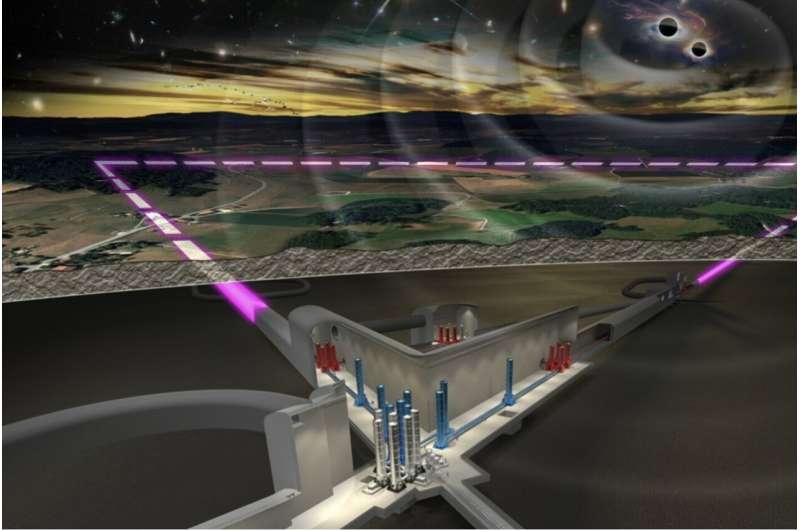This article has been reviewed according to Science X's editorial process and policies. Editors have highlighted the following attributes while ensuring the content's credibility:
fact-checked
trusted source
proofread
CERN plans to collaborate with projects for future gravitational-wave observatories

Gravitational waves, like the discovery of the Higgs boson in 2012, have made their mark on a decade of extraordinary discoveries in physics. Unlike gravity, which is created when massive objects leave their mark in the fabric of spacetime, gravitational waves are very weak ripples in spacetime that are caused by gravity-accelerated masses.
So far, researchers have been able to detect the gravitational waves produced by the melting together of very heavy objects, such as black holes or neutron stars. When this happens, these echoes from the past reverberate through the whole universe and finally reach Earth, allowing us to piece together what happened millions of light-years ago.
Current gravitational-wave observatories can only detect a few gravitational waves as they cover just a narrow spectrum of the whole range of wavelengths that are emitted. Future gravitational-wave observatories, such as the Einstein Telescope, a CERN-recognized experiment, need to be larger in order to search for a larger bandwidth of gravitational waves that could tell us more about the universe.
A key ingredient of future gravitational-wave observatories is ultra-high vacuum technology. As the world-leading R&D facility for applications in this field, CERN is one of the few places where people know how to build very long ultra-high vacuum systems. CERN's decade-long experience of installing complex and ultra-pure vacuum systems underground is an additional benefit for the Einstein Telescope since it will be installed at least 200 meters below the Earth's surface.
The lead institutes of the Einstein Telescope Collaboration therefore entered into a collaboration agreement with CERN in 2022. Building on this agreement, a workshop was held in March 2023 dedicated to brainstorming on how these systems might look and which materials would work best. The Collaboration hopes to complete a prototype vacuum pipe by the end of 2025. The findings from the workshop will help to reduce not only the cost of building the Einstein Telescope but also potentially the cost of future accelerators.
"The expected sensitivity of the Einstein Telescope will be at least a factor of ten times that of Ligo-Virgo," says Michele Punturo, who began his career as a physicist at CERN and is now the spokesperson of the Collaboration. "Its low-frequency sensitivity will allow us to detect intermediate mass black holes."
The Einstein Telescope is designed to measure gravitational waves ten times more precisely than existing gravitational-wave detectors and will complement future space-based gravitational wave detectors. The experiment will send a laser beam down into the 120-km-long triangular-shaped tunnel.
This beam will be then split into two beams, which are reflected by mirrors. The length of the tunnel has been chosen so that the two laser beams precisely cancel each other. If a gravitational wave crosses the laser signal, it will be perturbed, thus leaving behind an imprint of itself. The nature of this imprint will provide researchers with information about the event that created the gravitational wave in the first place.
Due to the high precision of the signal, the vacuum system in which the laser operates needs to be not only ultra-pure, but also free from vibrations as well as electromagnetic contamination, since both can mimic the signal from the incoming gravitational wave.
Another potential source of modification of the gravitational wave frequency is dark matter, the elusive form of matter that seems to make up most of our universe. Theorists are already working on models to verify whether a recorded signal could be influenced by dark matter. These searches would complement the searches for dark matter that are currently being carried out in collider and fixed-target experiments at CERN.
Provided by CERN




















